Photo Essay
Click on an photo for the full-size image.
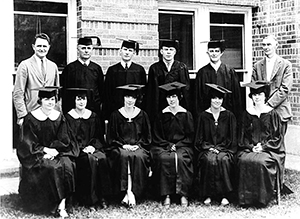
SFA's First Graduating Class, August, 1925: Front Row: Pearl Miller, Virginia Blackwell, Ruth Virginia Fouts, Lela Oxsheer, Gracie Mae Hornbuckle, Gladys B. Johnson; Back Row: Dean T. E. Ferguson, E. P. Gaines, C. Wedgeworth, Luther Garner, Hollis H. Hall, President A. W. Birdwell.
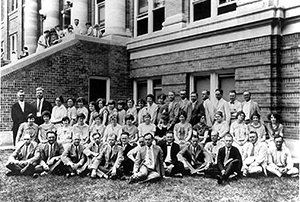
The Faculty, Summer School 1925: The photograph includes the extra faculty added for the summer sessions to handle the load of teachers who came to complete work and also to attend summer institutes. Karle Wilson Baker is in the center on the second row, her hair in a bun. President Birdwell and Superintendent R. F. Davis are on the back row left.
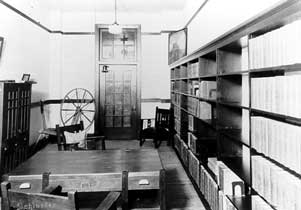
The Rare Book Room of the Rusk Library: In his first complete description of the Library for the Board of Regents in June of 1927, Birdwell wrote: "I desire to call special attention to our rare book room in which we have rare books and documents, some of which have been purchased by the college, and some have been donated by friends of the college. The furniture of the room was donated to the college by the Cum Concilio Club of Nacogdoches, and was made from walnut timbers of the original Stone Fort. The college is under many obligations to this splendid group of women for the interest they have shown in the library." Read more
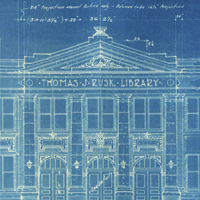
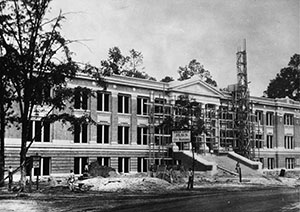
The Rusk Building Construction in 1926: This photograph is frequently mistakenly labeled the Austin Building. The Rusk structure has more elaborate architectural details than the Austin Building.
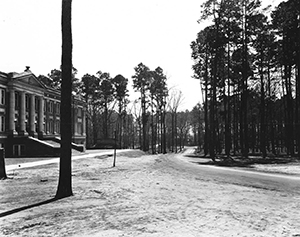
Campus Drive in front of the Rusk Building: The vast nature of the pine forest ("Owl Woods" as it was known before 1922) can clearly be seen. There is no paving, just a trail through the woods. Paving was the next item on Birdwell's agenda which he submitted to the Board of Regents in 1927.
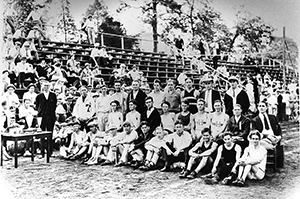
An early intercollegiate track and field meet at Birdwell Field around 1927: The photograph in the ETRC does not have a date. President Birdwell, standing by the table at the left, is preparing to give away the trophies. The "H" on the uniforms of the Sam Houston contestants can be seen in the second row right.
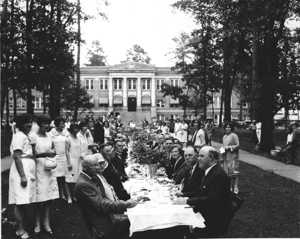
Banquet on the Vista: Legislative Review Panel has a formal lunch on the Vista in 1932. The students and faculty of the Home Economics Department prepared and served the event. The entertainment was provided by the band and choirs. Use of the Vista for official functions like graduations as well as for picnics and even exercise classes was common in the early years before there was a university center or an auditorium. Aikman Gym was the backup in case of bad weather.
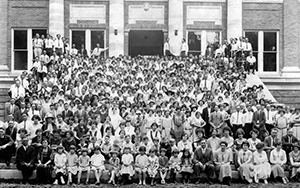
College Portrait: The whole college assembled on the steps of the Austin Building, 1927. Even the students from the Demonstration School are assembled in front. Dr. Birdwell is to the left front of the picture.
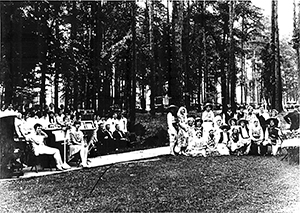
Band on the Vista: Pageants, entertainments, graduations, luncheons, etc. were all held on the Vista. This 1929 photograph shows the SFA orchestra on the left and the participants in a drama on the right. Think how much trouble it would have been to move two pianos half way down the Vista? What if it rained?
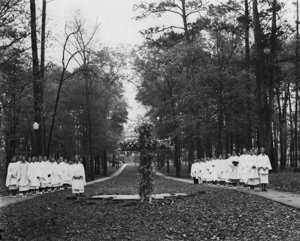
Sunrise Service on the Vista: Sunrise Easter Services on the Vista were a part of campus life from the beginning. The usual routine was to form a cross of the steps of the Austin building, then march down the Vista singing the “Pine Tree Hymn,” “Holy, Holy, Holy,” and “The Old Rugged Cross.” Passages of scriptures were read aloud by ministers, students, and faculty.
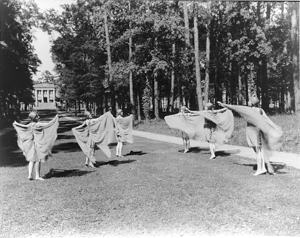
Nymphs on the Vista: Miss Virginia Broadfoot’s modern dance class were photographed here performing in butterfly costumes. Miss Broadfoot’s belief that the foundation of feminine beauty was a healthy body led her to emphasize not only calisthenics and sports activities, but also modern dance. All reports indicate that Miss Broadfoot was a rigorous taskmaster in pursuit of her feminine fitness program. Her ballet-like training for the women also made them popular participants in the theatrical productions of the time.
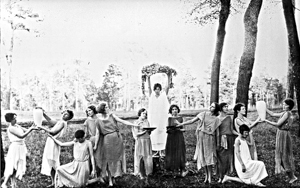
Tableaux on the Vista: In this photograph, ladies from the Literary Societies, in costumes and holding urns and laurels, depict a scene from a passage in Greek literature. Such silent and motionless scenes were common at the time. They called them tableaux or living pictures.
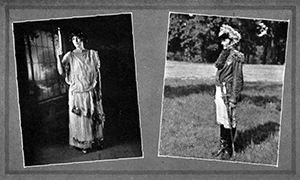
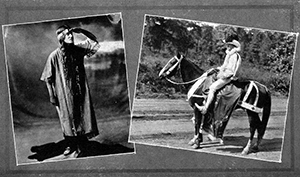
Nacogdoches Pageant: Scenes from the 1925 Nacogdoches Pageant which appeared in the 1926 Stone Fort. Angelina was represented in one scene, Spanish and French Explorers in others. Lawn parties where Sam Houston and Rusk were special guests were also part of the pageant. At the beginning of each scene the herald recited a few lines of blank verse giving the central idea.
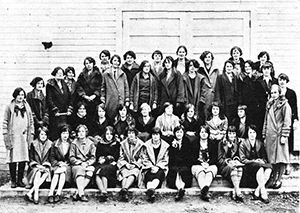
Womens Athletic Association: The Woman’s Athletic Association was one of the most representative organizations on the SFA campus. It was also the largest. It was organized in 1925. The ideal being promoted was that women should “weigh more carefully the value and necessity of physical training.” The idea of feminine beauty unaccompanied by health was decried. Their contention was that “every girl has her sport;” some use a tennis racket, others dance, others do more organize group sports. They requested women from all groups on campus.
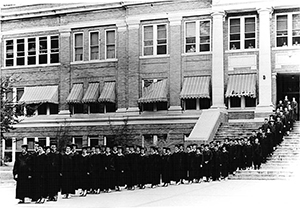
Graduation - 1929: Graduates file out of the Austin Building during a graduation ceremony in 1929.
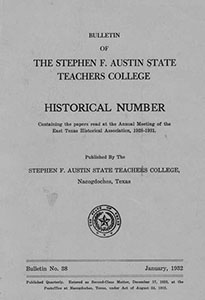
ETHA Bulletin: The cover of SFA Historical Bulletin No. 28 (1932); an earlier Bulletin No. 27 (1928) was the first publication. ETHA No. 28 had contributors from The University of Texas, East Texas State and Sam Houston State Teachers Colleges, and excellent articles from Lois Foster Blount and Rev. George L. Crockett of SFA. Mrs. Blount’s article was on the financial records of the Old Nacogdoches University.
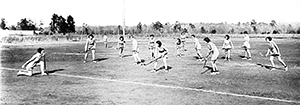
Women’s Field Hockey: The SFA Women’s Field Hockey Team of 1932. The field hockey teams were very active in the early years; the 1928 Stone Fort said: “They wield a wicked stick!” It was the “Basketball Girls” who in 1924 were the first women’s team to appear on campus and who were to continue to play an increasing important role. Volleyball was the chief game in classes.
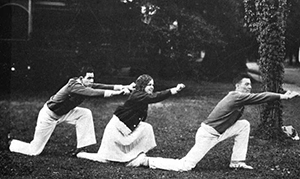
Yell Leaders - 1929: Miss Mary Lee Walton was the first woman to serve on a yell squad. She was elected, according to the Stone Fort Yearbook of 1929, because the student body “felt that the fairer sex needed a representative on the yelling staff, and after election she served so faithfully that she became indispensable.”